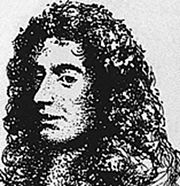Jacques Cassini facts for kids
Quick facts for kids
Jacques Cassini
|
|
|---|---|
 |
|
| Born | 18 February 1677 Paris Observatory
|
| Died | 16 April 1756 (aged 79) Thury
|
| Children | César-François Cassini de Thury |
| Scientific career | |
| Fields | Astronomy, Cartography |
Jacques Cassini was a French astronomer who lived from 1677 to 1756. He was the son of a very famous Italian astronomer, Giovanni Domenico Cassini. People often called him Cassini II.
Jacques Cassini was born at the Paris Observatory in France. He studied astronomy at home with his father. When he was just seventeen, he became a member of the French Academy of Sciences. In 1696, he was also chosen as a member of the Royal Society in London. While in England, he met other famous scientists like Isaac Newton and Edmond Halley.
Contents
Mapping the Earth's Shape
In 1712, Jacques Cassini took over his father's position at the Paris Observatory. He continued important work on measuring the Earth.
Measuring the Paris Meridian
In 1713, he worked on extending the Paris meridian. This was a long imaginary line running from Dunkirk in the north of France to Perpignan in the south. He measured a section of this line very carefully.
He published his findings in a book called Traité de la grandeur et de la figure de la terre (1720). This book was about the size and shape of the Earth.
The Earth's Shape Debate
At the time, scientists had different ideas about the Earth's shape.
- Some, called Cartesians, thought the Earth was shaped like a prolate spheroid. This means it was stretched out at the poles, like a rugby ball.
- Others, called Newtonians, believed it was an oblate spheroid. This means it was flattened at the poles and bulged at the equator, like a slightly squashed ball.
Cassini sided with the Cartesians. However, other scientists made observations that seemed to support the Newtonian idea. It's thought that Cassini might have realized the Newtonian measurements were more accurate.
Other Scientific Work
Jacques Cassini also wrote a book called Eléments d'astronomie (1740). This book discussed how stars move across the sky, which is called proper motion. In 1716, he published the first tables showing the positions of Saturn's satellites (moons).
Ballistic Pendulum Studies
Cassini also worked on something called a ballistic pendulum. This device helps measure how fast a projectile, like a cannonball, is moving. It was important for making more accurate firearms and artillery.
Historians still discuss how much of this work was Cassini's original idea. Another scientist, Benjamin Robins, later did similar work independently.
Creating the Cassini Map
In his later years, Jacques Cassini worked on map-making. He teamed up with his son, César-François Cassini de Thury, who was also known as Cassini III. Together, they started creating a very accurate map of France. This map became famous as the Carte de Cassini.
Family Life and Legacy
Jacques Cassini married Suzanne Françoise Charpentier de Charmois. Their second son, César-François Cassini de Thury, became a well-known astronomer too.
Jacques Cassini died in Thury, France, in 1756. The asteroid 24102 Jacquescassini is named after him to honor his contributions to astronomy.
Works
A number of his publications about astronomy are kept at the Paris Observatory library and can be found online:
- De la grandeur et de la figure de la terre, 1720 (About the size and features of Earth)
- Méthode de déterminer si la terre est sphérique ou non , 1738 (Method to determine if Earth is a sphere or not)
- Éléments d'astronomie , 1740 (Astronomy elements)
- Traité de la Comète qui a paru en décembre 1743 & en janvier, février & mars 1744 (About the comet that appeared December 1743, January, February and March 1744)
Images for kids
See also
 In Spanish: Jacques Cassini para niños
In Spanish: Jacques Cassini para niños


